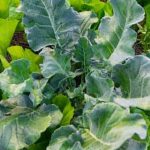Maintaining a weed-free garden is essential for the success of home vegetable gardens. Weeds not only compete with vegetable plants for vital resources but can also have a detrimental effect on their overall growth and health. In this article, we will explore the negative impact of weeds on vegetable plants and discuss how a well-maintained garden helps increase yields and overall success.
Weeds are relentless invaders that can rapidly take over a once-healthy vegetable garden if left unchecked. They rob valuable nutrients, water, and sunlight from the desired plants, stunting their growth and compromising their ability to develop healthy fruits or vegetables. Not only do weeds hinder the productivity of our gardens, but they can also introduce diseases and pests that further harm our beloved vegetables.
However, by implementing effective weed control strategies, we can create an environment where our vegetables thrive. A well-maintained garden ensures that our crops receive all the necessary resources they need to grow strong and bountiful. With proper weed management techniques in place, we can maximize yields, improve crop quality, and reduce the chances of plant diseases infiltrating our vegetable plots.
In the following sections of this article, we will delve into different types of weeds commonly found in home vegetable gardens. We’ll also explore the effects weeds have on these gardens and discuss proactive prevention methods as well as organic and chemical control options. By gaining an understanding of these aspects of weed management, readers will be equipped to achieve a healthy and thriving vegetable garden that is free from invasive weeds.
Different types of weeds commonly found in home vegetable gardens
In home vegetable gardens, there are various types of weeds that commonly make an appearance. It is crucial for gardeners to be able to identify these different weed species in order to effectively combat them and prevent their negative effects on the garden. By understanding the characteristics and growth habits of these weeds, gardeners can implement targeted control methods and minimize their impact on vegetable plants.
One common weed found in home vegetable gardens is the dandelion (Taraxacum officinale). Dandelions have deep taproots that allow them to compete with vegetable plants for nutrients and water. They also produce numerous seeds that can quickly spread throughout the garden if left unchecked.
Another frequent invader is crabgrass (Digitaria spp. ), which tends to thrive in warm weather and quickly spreads through long, creeping stems known as stolons. Crabgrass competes with vegetables for essential resources and can smother young seedlings if not controlled.
Purslane (Portulaca oleracea) is another weed commonly found in vegetable gardens. This succulent plant has fleshy leaves and stems, which allow it to survive dry conditions. Purslane reproduces through copious amounts of seeds and can quickly take over a garden if not managed properly. Additionally, chickweed (Stellaria media) often invades vegetable gardens, growing in dense clusters and forming a thick mat that smothers nearby plants. Chickweed is known to rapidly spread through its ability to produce numerous seeds.
| Weed Species | Characteristics | Growth Habits |
|---|---|---|
| Dandelion (Taraxacum officinale) | Deep taproot; produces numerous seeds | Competes for nutrients and water; quick spread through seeds |
| Crabgrass (Digitaria spp.) | Long, creeping stems known as stolons | Competes for essential resources; smothers seedlings |
| Purslane (Portulaca oleracea) | Fleshy leaves and stems; reproduces through seeds | Survives dry conditions; quick spread through seeds |
| Chickweed (Stellaria media) | Grows in dense clusters; forms thick mats | Rapid spread through abundant seeding |
These are just a few examples of the types of weeds commonly found in home vegetable gardens. By familiarizing themselves with these weed species and their growth habits, gardeners can devise effective strategies to control and minimize their impact on their beloved vegetable plants.
The effects of weeds on home vegetable gardens
Weeds are more than just unsightly nuisances in a home vegetable garden; they can have a significant impact on the growth and health of vegetable plants. When left unchecked, weeds can compete with vegetables for essential resources such as water, sunlight, and nutrients. This competition can result in stunted growth, reduced yields, and an overall decrease in plant vigor.
One of the primary ways that weeds negatively affect home vegetable gardens is by competing for water. Weeds have extensive root systems that allow them to absorb significant amounts of water from the soil. As a result, vegetable plants may become deprived of adequate moisture, leading to wilting and increased susceptibility to stress and diseases.
In addition to water competition, weeds can also shade out surrounding vegetable plants. Tall or fast-growing weeds can block sunlight from reaching the vegetables, inhibiting photosynthesis and reducing their ability to produce energy. This lack of light can weaken plant growth and compromise their ability to develop strong stems and healthy foliage.
Not only do weeds pose physical challenges for vegetable plants, but they can also create a more favorable environment for pests and diseases. Weeds provide shelter for insects, rodents, and other pests, which may then move onto neighboring vegetable crops. Similarly, dense weed growth often limits airflow around the plants, creating conditions that are conducive to fungal diseases.
| Effect | Description |
|---|---|
| Water competition | Weeds absorb large amounts of water from the soil, depriving vegetables of necessary moisture. |
| Shading | Tall or fast-growing weeds block sunlight from reaching vegetables, inhibiting photosynthesis. |
| Providing shelter for pests | Weeds create a habitat for insects and rodents that can then move onto vegetable crops. |
| Promoting diseases | The dense growth of weeds limits airflow, creating conditions that are conducive to fungal diseases. |
It is crucial for home gardeners to address the effects of weeds early on in the growing season to ensure the success of their vegetable gardens. By implementing effective weed control strategies, such as regular monitoring, timely intervention, and proper maintenance, gardeners can minimize the negative impact of weeds and create an environment that promotes optimal growth and yield.
Prevention and proactive weed control strategies
Minimizing the likelihood of weed invasion
In order to maintain a healthy and thriving home vegetable garden, it is essential to implement prevention and proactive weed control strategies. By taking certain measures, gardeners can minimize the likelihood of weeds invading their vegetable beds.
One effective strategy is mulching. Applying a layer of organic mulch, such as straw or wood chips, around the plants helps suppress weed growth by blocking sunlight from reaching the soil surface. Additionally, mulch helps conserve soil moisture and regulates soil temperature, creating a more favorable environment for vegetable plants while inhibiting weed establishment.
Another preventative measure is crop rotation. Rotating crops each growing season prevents weeds that are specific to certain vegetables from becoming established and spreading. By changing the location of different crops within the garden, gardeners discourage weeds adapted to those particular vegetables from persisting in the same area year after year.
Proper spacing to reduce weed competition
Proper spacing between plants also plays a crucial role in weed prevention and control. Crowded plants provide favorable conditions for weeds to thrive because they create dense foliage that shades out surrounding areas less effectively. Adequate spacing allows for better air circulation and light penetration, which aids in drying out the soil surface more quickly after irrigation or rainfall, making it less conducive for weed germination.
Additionally, proper spacing reduces competition among plants for essential resources such as water and nutrients. When vegetables are spaced too closely together, their root systems become entangled with each other, leaving little space for water and nutrients to be absorbed efficiently by individual plants. This not only weakens vegetable plants but also provides an opportunity for aggressive weeds to outcompete them.
Weed control barriers
Implementing physical barriers can also help prevent weeds from infiltrating vegetable beds. Installing landscape fabric or permeable plastic sheeting under pathways or between rows creates an obstacle that hinders weed growth. These barriers prevent weed seeds from germinating and make it easier to pull out any weeds that do manage to sprout.
When using landscape fabric or plastic sheeting, it is important to ensure proper installation and maintenance. Gardeners should secure the edges of the fabric or sheeting to prevent wind or pests from lifting it, which can provide opportunities for weeds to grow. Regular inspection and removal of any debris accumulated on the barrier’s surface can further deter weed growth.
By employing these prevention and proactive weed control strategies, gardeners can significantly reduce the presence of weeds in their home vegetable gardens. Taking these measures not only ensures a healthier garden but also minimizes the amount of time and effort spent on removing established weeds throughout the growing season.
Organic weed control methods
Hand Weeding
Hand weeding is a simple and effective method for removing weeds from the garden. It involves physically pulling out weeds by hand, roots and all. For best results, it is important to remove weeds before they have a chance to set seed and spread. Hand weeding can be time-consuming, especially in larger gardens, but it offers the advantage of being precise and selective, targeting only the undesirable plants.
Hoeing
Hoeing is another traditional method used to control weeds in vegetable gardens. It involves using a sharp hoe to cut or uproot young weeds just below the soil surface. By disturbing their roots, hoeing interrupts the growth cycle of weeds and prevents them from competing with vegetable plants for resources. Hoeing should be done when the soil is dry to prevent weed roots from re-rooting.
Natural Mulches or Cover Crops
Applying natural mulches, such as straw or wood chips, can help suppress weed growth in vegetable gardens. Mulches create a barrier between the soil surface and sunlight, preventing weed seeds from germinating and establishing. Similarly, cover crops like clover or buckwheat can be sown between rows of vegetables to act as living mulch, crowding out potential weed competitors.
Implementing these organic weed control methods requires diligence and regular monitoring of the garden. Weeds should be addressed as soon as they are noticed to prevent them from quickly spreading across the garden bed.
While organic methods may require more effort compared to chemical herbicides, they offer the advantage of being safe for the environment and not posing any risks to human health or beneficial garden insects. By incorporating these techniques, gardeners can effectively manage weeds and maintain a healthy home vegetable garden naturally.
Herbicides and chemical weed control options for home vegetable gardens
When it comes to maintaining a weed-free vegetable garden, herbicides and chemical weed control options can be effective tools in the gardener’s arsenal. However, it is essential for home gardeners to approach the use of these products with caution and adhere to proper guidelines. This section will discuss the use of herbicides in home vegetable gardens, emphasizing the importance of choosing the right product and following instructions carefully.
Before using any herbicide in a vegetable garden, it is crucial to read and understand the label instructions thoroughly. Different herbicides have specific instructions regarding application rates, timing, and targeted weeds. Following these instructions diligently ensures that the product is used in the safest and most effective manner possible.
There are various types of herbicides available for at-home use in vegetable gardens. Selective herbicides target specific types of weeds while sparing desirable plants, making them suitable for use in situations where broadleaf or grassy weeds need to be controlled selectively. Non-selective herbicides, on the other hand, kill most plants they come into contact with and should be used with extreme care around vegetables.
While chemical weed control options can be effective, it is important to note any potential safety concerns associated with their use. Some herbicides may have restrictions on their usage if certain crops are grown nearby or if there are restrictions on harvest intervals after treatment. Additionally, precautions such as wearing protective clothing or gloves during application should always be taken.
By choosing the right herbicide for the specific weed problems faced in a home vegetable garden and following label instructions carefully, gardeners can effectively manage weeds without causing harm to their desired crops. It is also essential to keep in mind that relying solely on chemical weed control options may not be sustainable long-term. Therefore, integrated approaches using a combination of preventive measures along with judicious use of appropriate herbicides will help ensure a healthy and thriving vegetable garden.
In the next section, we will discuss the timing and frequency of weed control tasks, providing guidelines on when and how often to implement different weed control methods throughout the growing season.
Timing and frequency of weed control tasks
One of the key aspects of successful weed control in home vegetable gardens is understanding the importance of timing and frequency when it comes to tackling weeds. Regular monitoring and addressing weeds in a timely manner can prevent larger problems down the line and ensure that your vegetable plants are not hindered by weed competition. Here are some guidelines on when and how often to implement different weed control methods throughout the growing season:
- Early Season: Start your weed control efforts early in the season before weeds have a chance to become established and compete with your vegetable plants. Clear any existing weeds or debris from the garden bed before planting. As soon as you see weed seedlings emerging, take action to eliminate them. This can be done through hand weeding or shallow cultivation.
- Ongoing Maintenance: Throughout the growing season, it’s important to regularly monitor your garden for any new weed growth. Weeds can quickly take advantage of space left by harvested crops or areas where vegetables may have been damaged or removed due to pests or diseases. Aim for weekly inspections and address any emerging weeds promptly.
- Mulching: Applying an organic mulch around your vegetable plants not only helps retain soil moisture but also acts as a barrier against weed growth. Apply mulch once your vegetable plants have established themselves, typically a few weeks after transplanting or direct seeding. Keep the mulch layer thick enough (about 2-4 inches) to effectively suppress weeds.
- Cultivation: Cultivating between rows or within planting beds can help disrupt the growth of weeds and prevent them from spreading further. Be cautious when using cultivation tools near delicate vegetable roots to avoid damaging them.
- Hand Weeding: Hand pulling or cutting weeds is another effective method for small-scale gardens or areas with dense weed populations that cannot be easily managed through other methods alone. Make sure to remove both the above-ground parts and as much of the root system as possible.
Remember, consistency is key when it comes to weed control. By staying vigilant and implementing these strategies at the right time and frequency, you can keep your home vegetable garden free from weeds and maximize your crop’s growth and yield.
Long-term weed control strategies and maintenance
Weed control in home vegetable gardens is an ongoing task that requires a combination of preventative measures and proactive strategies. While it’s important to address immediate weed issues, it’s equally crucial to implement long-term weed control strategies for sustained success. Here are some effective approaches to consider:
- Ground covers: Utilizing ground covers in your garden can help suppress weed growth by blocking sunlight and preventing seeds from germinating. Options like landscape fabric, straw mulch, or organic mulches provide excellent coverage while also improving soil moisture retention.
- Proper sanitation: Maintaining proper sanitation practices can significantly reduce the likelihood of weeds taking hold in your vegetable garden. Be sure to promptly remove any crop residues or dead plants at the end of each growing season. Additionally, regularly clean gardening tools and equipment that may harbor weed seeds.
- Integrated pest management (IPM): Implementing an integrated pest management approach can help minimize weeds in your vegetable garden while also addressing other potential pests. This approach combines various techniques such as cultural practices (crop rotation, proper spacing), biological controls (using beneficial insects), and mechanical controls (hand-weeding) to manage pests, including weeds.
Long-term maintenance is crucial for preventing the reestablishment of weeds in your home vegetable garden. It is recommended to regularly monitor your garden for any signs of weed growth and address them promptly before they become a larger problem. Implementing regular weeding tasks and maintaining healthy plant growth will help prevent weed competition.
Remember that achieving a weed-free vegetable garden requires consistent effort throughout the growing season. By incorporating long-term weed control strategies into your routine maintenance tasks, you can create a flourishing environment for your vegetable plants while keeping pesky weeds at bay. With dedication and a proactive mindset, you can enjoy the fruits of your labor with an abundant and healthy harvest.
Conclusion
In conclusion, maintaining a weed-free home vegetable garden is crucial for the overall success and productivity of your plants. Weeds not only compete with vegetables for essential resources such as water, sunlight, and nutrients but they can also harbor pests and diseases that can further damage your crops. By implementing preventative measures such as mulching, crop rotation, and proper spacing, you can minimize the likelihood of weeds invading your garden in the first place.
For those who prefer organic methods, there are several eco-friendly approaches to weed control that don’t rely on chemical herbicides. Hand weeding, hoeing, and using natural mulches or cover crops are effective techniques to keep weeds at bay while being environmentally friendly. However, if you do choose to use herbicides in your vegetable garden, it’s important to select the right product and follow instructions carefully to ensure safety and effectiveness.
Timing and frequency are key when it comes to weed control tasks. Regularly monitoring and addressing weeds can prevent larger problems from arising later on. Be sure to implement different weed control methods throughout the growing season based on guidelines specific to each technique.
To achieve long-term weed control and maintenance, consider sustainable approaches such as using ground covers, practicing proper sanitation, and implementing integrated pest management (IPM) techniques. These strategies will help prevent reestablishment of weeds over time.
Frequently Asked Questions
Is there a weed killer safe for vegetable gardens?
Yes, there are weed killers that are safe for vegetable gardens. It is important to choose a product that is specifically labeled as safe for use in vegetable gardens. These weed killers are formulated to be selective, targeting only the weeds while not harming the vegetables.
Some common examples of safe weed killers for vegetable gardens include herbicides containing acetic acid (vinegar-based), clove oil-based herbicides, or fatty acid-based herbicides. It is crucial to carefully read and follow the instructions on the product label to ensure it is used correctly and safely in your vegetable garden.
How do I control weeds in my vegetable garden?
There are several effective methods to control weeds in a vegetable garden. The first step is maintaining good garden hygiene by regularly removing any existing weeds manually before they go to seed. This prevents them from spreading and multiplying.
Mulching can also be employed as a preventive measure by covering the soil around your vegetables with organic mulch like straw or wood chips, which helps suppress weed growth by blocking sunlight and providing a physical barrier against emerging weeds. Regularly cultivating the soil between rows or around individual plants using a hoe or hand tool can help disrupt weed growth too. Additionally, practicing crop rotation and ensuring proper spacing between plants can help create unfavorable conditions for weed establishment.
What weed killer can you use around vegetables?
When it comes to using weed killer around vegetables, it is essential to prioritize safety and select specific products approved for such use. Non-selective herbicides like glyphosate should be avoided as they can harm both weeds and desirable plants alike. Instead, opt for selective herbicides that are formulated to target broadleaf weeds or grassy weeds without causing harm to vegetables when used according to instructions.
Herbicides containing active ingredients such as pelargonic acid or ammoniated soap of fatty acids are often considered safe options for use in vegetable gardens when applied precisely following label recommendations. Always exercise caution when using any chemical intervention, carefully read labels, wear appropriate protective gear, and avoid spraying on windy days to minimize drift and unintended damage.

If you’re looking to get into vegetable gardening, or are just looking for some tips on how to make your current garden better, then you’ve come to the right place! My name is Ethel and I have been gardening for years. In this blog, I’m going to share with you some of my best tips on how to create a successful vegetable garden.





